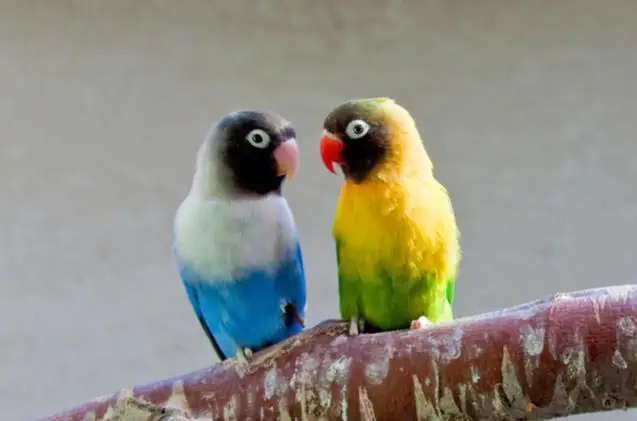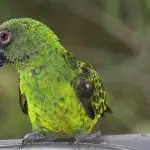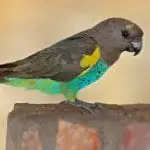Scientific Facts
| Common Name | Green Masked Lovebirds, Black Masked Lovebird, Masked Lovebird, & Blue Masked Lovebird. |
| Scientific Name | Agapornis personata. |
| Size | 6 inches |
| Life Span | 15-20 years |
| Habitat | well-wooded grasslands |
| Country of Origin | Africa— Tanzania |
The Masked Lovebird induces a hurricane of delight in every residence it infiltrates. They are one of the cutest, silliest, and most dynamic pet lovebirds you can engage, similar to all the other lovebirds. There’s no end to entertainment with these little, “pouched-sized” birds, and with their superior stamina, attractive character, and small size, they can be an excellent amateur’s pet. An enduring bond will instantly thrive, and you’ll discover that there is so much to admire about these playful small lovebirds after you become to understand one another.
Physical Description
This species is likewise considerably tiny, similar to the entire lovebirds. The grown-ups attain an entire range of 15 centimeters (6 inches). They are popular for their chubby, small tails that provide them a comprehensive heavy, plump appearance. They are rather friendly and might rely on the presence of another lovebird. It might be challenging deciding the suitable companion for your pet without any obvious variations within the sexes.
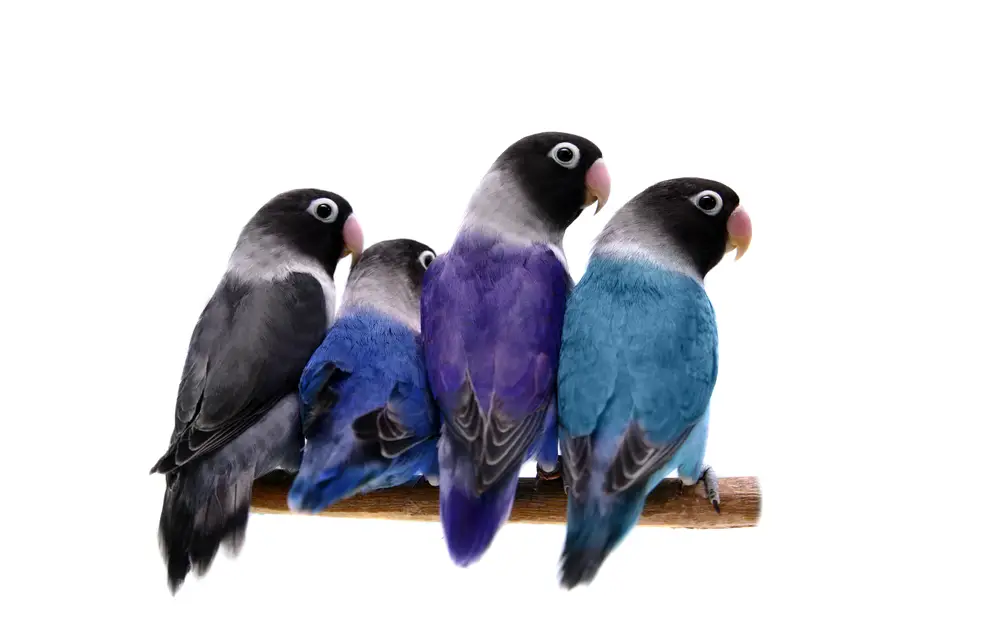
Sexing / Gender Identification: Females and males resemble equally in appearance, even if females are commonly bigger, and may possess a tinier, plumper head.
Feathers:
The under-tail, body, and belly plumes of the standard / generally-transpiring black-masked lovebirds are yellowish-green. The rear is greyish blue.
The under-plume feathers are grey-blue. The upper surface of the plumes is deep green; the bottom is paler. The aviation plumage is black.
The temples, lores (the areas between the optics and beak on the side of a bird’s cranial), chops, and the section beneath the beak are brown-black. The dorsum of the cranial is a murky olive.
The chest and one section of the neck are yellow. About most of them, orange-red plumage can be observed on the upper thorax.
The tailpiece is emerald, and the exterior tail plumages are bound with an orange-yellow streak.
Eyes: White hoop circles both eyes. The irises are brown. The bill is red.
Legs: heels are grey
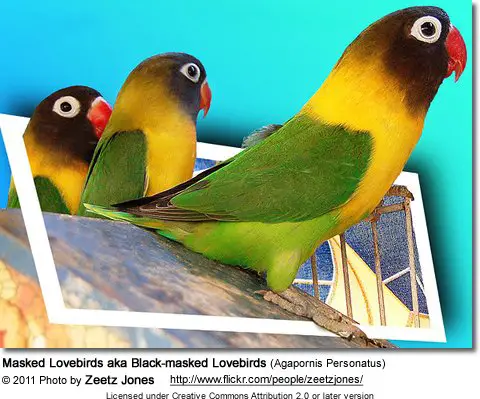
Crossbreeds between Fischer’s Lovebirds and Masked Lovebirds are also quoted popular in confinement and have likewise transpired in primitive communities. They are reddish-brown on the cranial and orange on the upper thorax, although contrarily match the Masked Lovebird.
Geographical Range
Masked Lovebirds, aka Yellow-collared Lovebirds (Agapornis personatus) or Black-masked Lovebirds, are stocky, small African lovebirds that are endemic to the provincial elevations of central and northern Tanzania in light covert and woods. Some flights can likewise be observed in the coastal areas of Tanzania and north-east Kenya.
In the late 1800s, the Masked Lovebird was found – but was not introduced until the 1920s. The blue modification also transpired in the native and was shipped shortly after its presentation.
Habitat
These lovebirds are endemic to the little district in northeast Tanzania, which is renowned for the Kilimanjaro, Lake Victoria, and Serengeti. They can frequently be viewed in small flights adjacent to springs of fresh water. They commonly favor arid areas with scattered extension adjacent to the forests. Some flocks also live in Burundi and Kenya, where they have been transported across ages.
Common Behavior
The masked lovebirds are pretty famous as an associate bird. Though they demand the camaraderie of a friend or mate, they are affectionate and affable. Pair can be noticed by feeding and grooming each other. It’s very appealing and entertaining to see.
More childish lovebirds are more comfortable to domesticate, but given conditions and care, the huge majority of adult birds will ultimately obtain faith and conquer their horror of individuals.
The lovebirds can be conjoined in partners or unaccompanied in an enclosure of average size. If the birds are held solely, domesticating is more natural. There need to be sufficient rounds in an enclosure so the lovebirds can propel around smoothly and maintain themselves occupied. One may infrequently give them withy branches to entertain themselves while gnawing. It is essential to equip them with more showering amenities than for different lovebirds; considering in nature, they remain in territories environed by water.
If kept alone, they need a portion of care from the master to compensate for the absence of an enclosure partner. This is not suggested unless you possess plenty of chance to present. As numerous lovebirds will, they are inclined to become hostile and insane, if overlooked.
In general, Lovebirds can be threatening to birds distant their species group. Attention is to be exercised when proposing new birds toward the range.
Contrary to some parrots, lovebirds don’t mimic human expression.
Language and Notes
They are not deemed to be extremely boisterous as pet birds. Their cry is a general chirping and twittering pattern for most minuter lovebirds that, although monotonous, is not excessively blatant.
Matched to their extent, this can present them as a suitable pet for both a condo and a residence. They can likewise be a little more calming than the larger parrots who fancy to imitate and speak a ton, demanding more endurance.
Diet & Feeding Habits
Lovebirds must be supplied with a caliber grain mix, in a supplement to presenting them with fruits and vegetables. It is advised to enhance their nutrition with minerals and vitamins. Bird-particular vitamins are accessible at the veterinary or more reliable pet shops.
Reproduction
In the wild, these lovebirds take over the nests of swifts, dwell in crevices of buildings, or the cracks of trees. When you equip them with a cradle crate, be certain to additionally present loads of willow branches, shreds of bark, or other nesting substances.
The female will produce three to four eggs, which are brooded for approximately 21 to 23 days. The juvenile abandon (bequeath the cradle) in roughly 44 to 45 days. When they grow self-sufficiently, transfer the juvenile into their home.
How to Breed
Sexing Lovebirds
It is difficult to identify the gender of juvenile Lovebirds without DNA analysis. Adult birds above one year can be genitally sexed.
- Grasp the lovebird in one hand, placing on its posterior in your hand;
- Sense merely beneath the limbs for two tiny lumps; these are the pelvic bones;
- Females will hold a notable space between these lumps to enable embryos to move, and a male will commonly possess two bumps adjacent or rubbing.
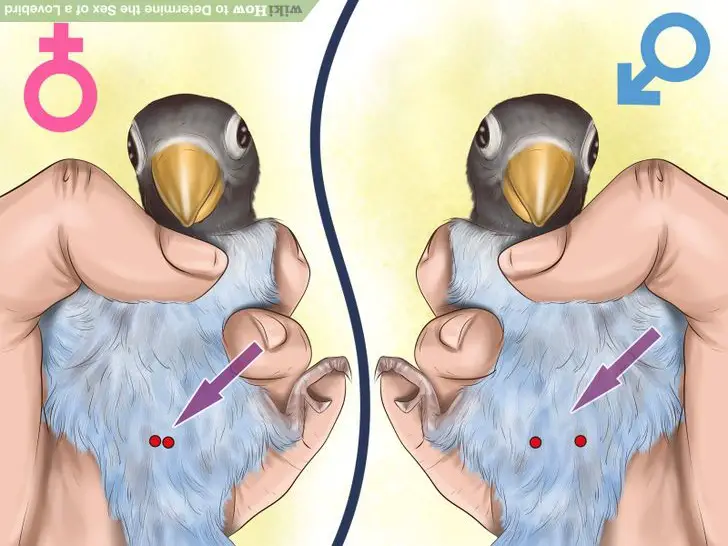
Reproducing these lovebirds is natural, and similar to most lovebirds, they need moisture for a prosperous brood. These lovebirds like tearing the paper, though when it gets to cradle making, they do not insert stuff within their plumes. They transfer stuff to their dwelling place with their noses.
Masked lovebirds can begin reproducing when they are as youthful as ten months of a span, and may extend until they are five to six years. They are extremely productive and may provide numerous egg clasps inside a single year. Because of this, they are normally promptly obtainable in the pet shop.
During the breeding season, the response between spouses will alter: the male exhibits more disruptive conduct, while the hens start arranging the cradle. There are particular dwelling crates for lovebird-size birds, but if not possible, a cockatiel dwelling crates will work perfectly subtle.
The cradles are essentially wholly built by the hens, and the three to six embryos are bred for approximately twenty-three days. The hens will charge them out or coat them with new dwelling substance and advance to produce more embryos if the embryos are sterile. The youngsters will be attended by the hen until they abandon the cradle at nearly six weeks of age. The father then drives over the supplying of the juvenile lovebirds for added two weeks or hence, until they are detached.
Throughout the breeding term, these lovebirds must be supplied with a mixture of vegetables, fruits, pellets, and seeds. Providing the birds a nutritive menu during reproducing will deliver strong infants. They require to be transferred proximately ten days if the babies are discharged for hand ingesting. Hand ingesting will generate wonderful lovebirds though time demands to keep back to associate with the babies. Mingling the babies will get them trusting and challenging. It is likewise an excellent approach to begin including vegetables and fruits into their nutrition at an early age. This causes them less prone to possess obstacles later when fresh meals are offered.
Pet Care
Housing
An enclosure as large as 91X61X61 cms are adequate for the active bird. The pouch lovebird favors remaining with a flock (different lovebirds) that supports the specification of a larger enclosure. Furthermore, the enclosure must be holding four roosts, playthings, and separate containers for water and food without getting the room a jumble. In summary, make certain a modest measure of scope is given for the flight of the bird.
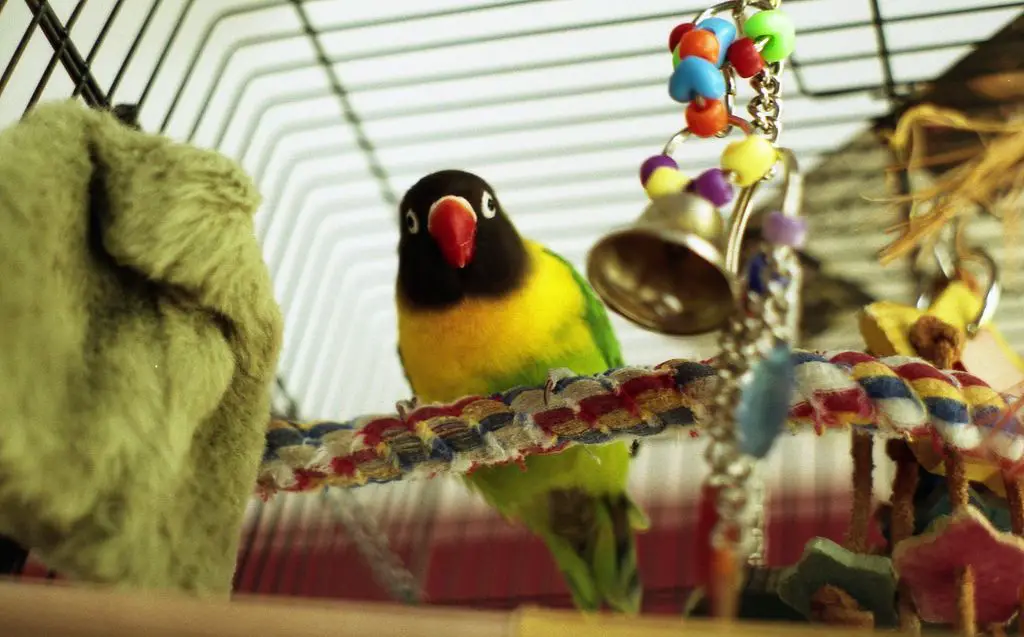
Temperature
The standard daylight condition scale is 70°F-80° with a slight decline during the evening is admissible by the bird.
Feeding
The Masked Lovebird diet is mainly made up of nuts, crops, fruits, and seeds as parrots in the wild. The standard pre-made pellet and seed mix intended at lovebirds will serve merely excellent as the source of their nutrition. To support it out, you must supplement some raw leafy herbs, like spinach, kale, cabbage, and lettuce, as healthy as some raw.
Care
Physical grooming, as well as mental enrichment, solely comes toward the section of attending for the bird.
If you own a single lovebird, then make certain you associate with it constantly and don’t allow it to become tedious. Know its demand by its body expression, and you will possess a pleasant and lively lovebird. Gain its credence, and the bird will be comfortable to domesticate. You may employ a branch to flatter the bird. However, if you have a couple, you will need to observe their dating or understanding from a length.
Equip lukewarm water, creating a vapor shower, or a shower vessel must be regular. The roosts fixed within the enclosure, treat the bird with the sustaining of its beak and nail.
Health Requirements
Masked lovebirds are an exceptional option for amateur keepers for several purposes. One of these purposes is its robust fitness and surpassing sense to adjust to natural circumstances. To have it similar to this, make positive you suffice some conditions, like good hygiene, enough sunlight, and optimal temperature. Provide for a lot of opportunities outside the enclosure – those small birds are abundant of strength and desire to traverse. Loads of soaring time is inevitable to maintain their content and fit.
Health problems
Masked lovebirds are generally firm and healthy birds, and having them in partners is one of the foolproof techniques to guarantee their excellent wellness. Still, some problems like intestinal influenza, parasitic or coccidiosis disease, yeast or candidiasis infection, Feather Disease, and Psittacine Beak can induce problems at times. If following standard nutrition and orderly living, the bird is coming unhealthy, bring it to a doctor.
Availability
The Masked Lovebird is extremely famous and is promptly accessible.
Though, for the blue-masked lovebird, it is formidable to obtain a single species; however not improbable, so the value may be a bit costlier than even a couple, sometimes. A single lovebird is possible within $85-$88, while a couple is marketed in $75-$77.
Choosing a Pet Masked Lovebird
If you determine a Masked Lovebird would adequately satisfy your personage, it is best to obtain one that is hand-raised, indicating they are bred to be gentle partners. Taking the healthiest most productive bird is not solely you will be seeking for, apply the tips below to assist you throughout the method.
- Provide ample time to witness the Lovebirds in their enclosure; this is where they are most relaxed and will reveal their natural colors
- Mark for a tight, bright, and active plumed Lovebird. Don’t pick the variation over the entire appearance of the bird. If the lovebird displays special attention in you and has clean, bright eyes, the vent (bum) and clean beak (mouth), this would be the most desirable Lovebird to contemplate bringing home
- Constantly guarantee they are completely removed (consuming separately, no ratio). At least two weeks from detaching is perfect. If you perceive the Lovebirds feeding in their enclosure, that is a healthy indication. Don’t be enticed to purchase a juvenile Lovebird that is not detached precisely or too childish as it will solely settle in trouble.
- Whenever purchasing a Lovebird, consider distinct concern in their maintenance situations. Enclosures must have no smell, be clean, and brightly lit. Any being held in overpopulated, moist or unsanitary situations are more sensitive to infection and a symbol of inadequate management
- Guarantee you possess the needed confederates before choosing up your new Lovebird. If you are purchasing a Lovebird from a grower or shop that does not market accessories, inquire what kind of diet they are serving already and have it prepared.
- Never order a hand trained bird you have not touched. Every bird holds its matches/aversions and character. A healthy hand trained Lovebird will perch on your fingers/collar with slight hesitation and is likewise a great opportunity to examine the bird’s physical health; vent/feet/beak/eyes
- When shipping your new bird home, secure they are accurately carried, most good pet shops will market bird carrier enclosures/receptacles.
FAQs
How long do black masked lovebirds live?
Your bird’s existence can remain between 10 to 20 years in confinement with decent attention.
What do masked lovebirds eat?
Lovebirds must be served a class grain mix, in enhancement to giving them with fruits and vegetables.
How much does it cost to buy a lovebird?
The selection charge ranges according to species. There are likewise considerably various online websites retailing lovebirds. Mask lovebird at $80.99 to $87.99 each
Where do lovebirds sleep?
Lovebirds commonly desire to dream on the highest roost in their enclosure.
Should lovebirds be covered at night?
As long as a shady, peaceful, and somewhat isolated space is given for a bird to relax in, most will be subtle without being capped at night.
How often does a lovebird poop?
Poop cycle: once in every 30-40 mins

